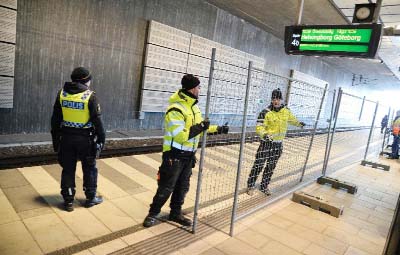
AFP, Copenhagen :
For the first time in half a century, Sweden was demanding photo identification for all travellers from Denmark in a drastic move to stem an unprecedented influx of refugees.Extra security staff were on hand to oversee the new border controls on the Danish side of the Oresund bridge-and-tunnel link, a major entry point for migrants and refugees hoping to start a new life in Sweden.
Marten Jegenstam, a 41-year-old consultant who lives in Denmark but works in Sweden, said that controls were needed.
“I think we need some control (over our borders) but it needs to be very smooth, the commuting back and forth requires balance,” he said. Under the new rules, rail passengers will have to exit the train and clear checkpoints before boarding the train again. Those without valid ID will be refused entry.
Travellers had been warned to expect long queues and delays in the afternoon when many commuters began returning to Sweden from their jobs in the Danish capital city. The measures aim to keep out undocumented migrants and come after Sweden — which has taken in more asylum seekers per capita than any other European nation — said it could no longer cope with the unregulated flow of new arrivals.
A temporary fence has already been erected at Copenhagen airport’s Kastrup station, where trains will be stopped for mandatory controls. “It’s as if we are building a Berlin Wall here. We are going several steps back in time,” said Michael Randropp, a spokesman for the local Kystbanen commuters’ association.
The re-introduction of border controls means that travellers between the two Nordic countries will have to show photo ID for the first time in more than 50 years and deals yet another blow to Europe’s cherished passport-free Schengen system.
Several other European Union countries, including Germany, Austria and France, also re-imposed border checks last year as the continent grappled with its biggest refugee crisis since World War II.More than one million migrants reached Europe in 2015, most of whom were refugees fleeing war and violence in Syria, Afghanistan and Iraq, according to the United Nations refugee agency.
For the first time in half a century, Sweden was demanding photo identification for all travellers from Denmark in a drastic move to stem an unprecedented influx of refugees.Extra security staff were on hand to oversee the new border controls on the Danish side of the Oresund bridge-and-tunnel link, a major entry point for migrants and refugees hoping to start a new life in Sweden.
Marten Jegenstam, a 41-year-old consultant who lives in Denmark but works in Sweden, said that controls were needed.
“I think we need some control (over our borders) but it needs to be very smooth, the commuting back and forth requires balance,” he said. Under the new rules, rail passengers will have to exit the train and clear checkpoints before boarding the train again. Those without valid ID will be refused entry.
Travellers had been warned to expect long queues and delays in the afternoon when many commuters began returning to Sweden from their jobs in the Danish capital city. The measures aim to keep out undocumented migrants and come after Sweden — which has taken in more asylum seekers per capita than any other European nation — said it could no longer cope with the unregulated flow of new arrivals.
A temporary fence has already been erected at Copenhagen airport’s Kastrup station, where trains will be stopped for mandatory controls. “It’s as if we are building a Berlin Wall here. We are going several steps back in time,” said Michael Randropp, a spokesman for the local Kystbanen commuters’ association.
The re-introduction of border controls means that travellers between the two Nordic countries will have to show photo ID for the first time in more than 50 years and deals yet another blow to Europe’s cherished passport-free Schengen system.
Several other European Union countries, including Germany, Austria and France, also re-imposed border checks last year as the continent grappled with its biggest refugee crisis since World War II.More than one million migrants reached Europe in 2015, most of whom were refugees fleeing war and violence in Syria, Afghanistan and Iraq, according to the United Nations refugee agency.

